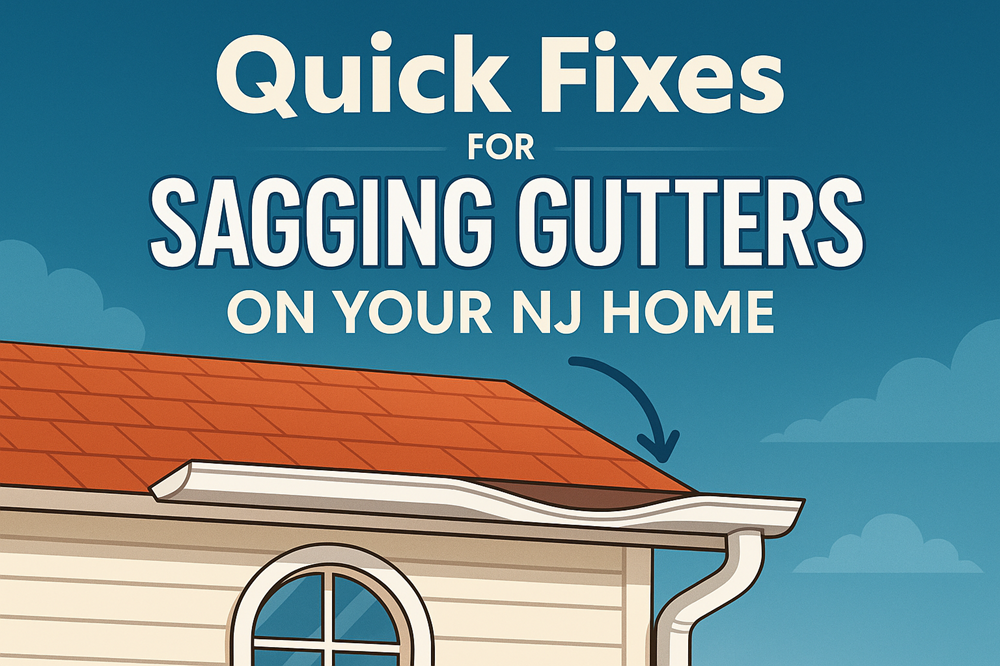Quick Fixes for Sagging Gutters on Your NJ Home

Strong 8k brings an ultra-HD IPTV experience to your living room and your pocket.
At first glance, sagging gutters might appear to be a minor issue, but ignoring them can result in significant damage to your home over time. In New Jersey, with its mix of rainy springs, snowy winters, and falling autumn leaves, your gutters go through a lot. Over time, they can start to pull away from the roof or dip in the middle, causing water to overflow or pool in the wrong places.
The upside is that most sagging gutter issues can be resolved simply and swiftly with basic tools and a little effort. Whether you're a handy homeowner or just trying to prevent future issues, here’s a simple guide to quick fixes for sagging gutters on your NJ home.
What Causes Gutters to Sag?
Before we jump into the fixes, it’s helpful to understand what’s causing the sagging in the first place. Here are some common reasons:
- Clogged gutters: Leaves, dirt, and debris can weigh down your gutters, especially after heavy rain or snow.
- Loose fasteners: Over time, screws, nails, or brackets holding the gutters in place can loosen or fall out.
- Damaged hangers: The metal supports that attach your gutters to the house can bend or break.
- Improper slope: Gutters should be gently angled so that water flows smoothly in the direction of the downspout. If they’re not angled correctly, water can pool and cause sagging.
- Rotting fascia board: If the wood the gutters attach to becomes soft or rotted, the gutters won’t stay secure.
Now that we know what causes sagging, let’s look at how to fix it.
Step 1: Clean Out the Gutters
The first step in any gutter fix is to make sure they’re clean. Clear out leaves, twigs, and debris using either a small scoop or your hands while wearing gloves. Then rinse the gutters with a hose to check how water flows. If you notice standing water, that’s a sign of poor slope or blockage.
Keeping your gutters clean not only solves some sagging problems but also helps you spot any damage that needs fixing.
Step 2: Tighten or Replace Gutter Fasteners
Sagging gutters often result from screws or nails that have become loose over time. Grab a screwdriver or drill and check each fastener. If any are loose, tighten them. If they don’t grip the wood anymore, replace them with longer screws or gutter spikes.
Some homes use gutter hangers instead of spikes. They’re typically concealed within the gutter and clip into mounting brackets attached to the fascia board. If your hangers are bent or broken, swap them out with new ones from a hardware store.
Step 3: Add Additional Support
If your gutters are sagging in the middle, they might not have enough support. Add extra hangers or brackets every two feet along the length of the gutter to keep it straight and stable. Be sure to maintain the gutter’s natural angle, allowing water to drain properly toward the downspout.
Adding support is one of the easiest ways to prevent long-term sagging, especially on longer stretches of gutter.
Step 4: Check the Slope
Use a level to make sure your gutters are sloping slightly toward the downspout - about a quarter inch every 10 feet. If that angle is off, you might need to reposition the hangers to correct it. Loosen them, reposition the gutter to the correct angle, and then tighten them again.
Improper slope not only causes sagging but also leads to standing water, which can attract pests and cause rust.
Step 5: Inspect the Fascia Board
If fasteners won’t stay put or the wood feels soft, the fascia board may be rotting. Lightly press into the wood with a screwdriver to check its firmness. If it feels spongy or breaks apart easily, it’s time to replace that section of the board before reattaching the gutter.
Rotten fascia is a bigger job, but it’s important to fix it early to avoid more serious water damage.
When to Call a Professional
Sometimes the sagging is part of a bigger problem. If you notice multiple sections pulling away, major water damage, or gutter separation after storms, it might be time to bring in an expert. Companies that specialize in gutter repair in New Jersey can inspect your system and suggest the best long-term fix.
They can also help with larger issues like replacing rotten fascia, installing seamless gutters, or adding gutter guards to prevent clogs.
Final Tips to Keep Gutters in Shape
- Clean your gutters at least twice a year
- After strong storms, inspect your gutters for any signs of sagging or loosened hangers.
- Install gutter guards to reduce debris buildup
- Trim tree branches near your roof
- Watch for water stains or erosion around your foundation
Sagging gutters don’t have to be a major headache. With a few tools and some simple fixes, you can keep your gutter system working properly and protect your New Jersey home from water damage. Staying on top of these small repairs can save you money - and a lot of trouble - down the road.
Note: IndiBlogHub features both user-submitted and editorial content. We do not verify third-party contributions. Read our Disclaimer and Privacy Policyfor details.


